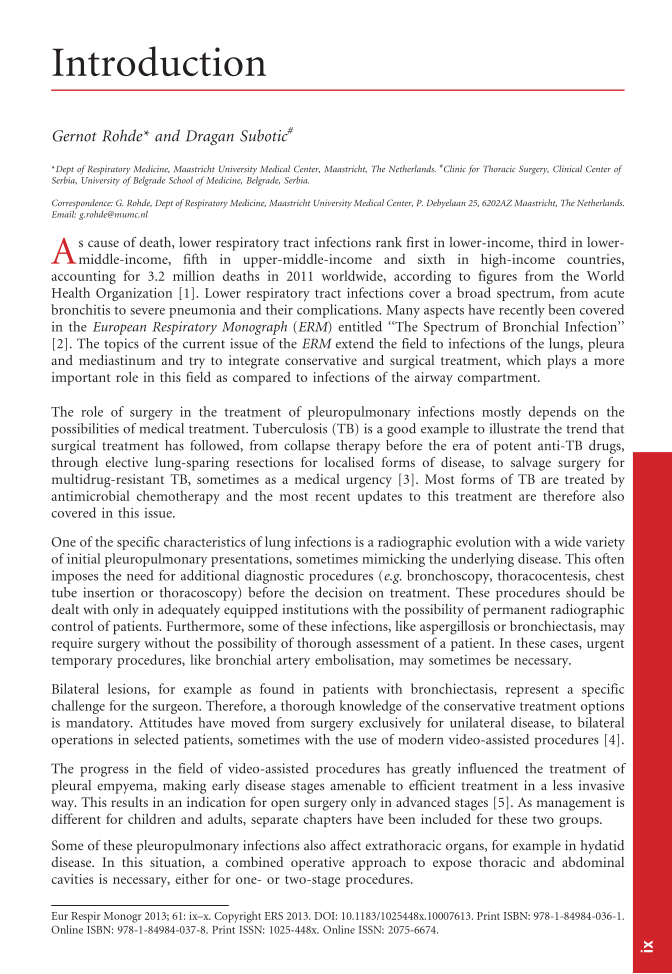Introduction Gernot Rohde* and Dragan Subotic# *Dept of Respiratory Medicine, Maastricht University Medical Center, Maastricht, The Netherlands. # Clinic for Thoracic Surgery, Clinical Center of Serbia, University of Belgrade School of Medicine, Belgrade, Serbia. Correspondence: G. Rohde, Dept of Respiratory Medicine, Maastricht University Medical Center, P. Debyelaan 25, 6202AZ Maastricht, The Netherlands. Email: g.rohde@mumc.nl A s cause of death, lower respiratory tract infections rank first in lower-income, third in lower- middle-income, fifth in upper-middle-income and sixth in high-income countries, accounting for 3.2 million deaths in 2011 worldwide, according to figures from the World Health Organization [1]. Lower respiratory tract infections cover a broad spectrum, from acute bronchitis to severe pneumonia and their complications. Many aspects have recently been covered in the European Respiratory Monograph (ERM) entitled ‘‘The Spectrum of Bronchial Infection’’ [2]. The topics of the current issue of the ERM extend the field to infections of the lungs, pleura and mediastinum and try to integrate conservative and surgical treatment, which plays a more important role in this field as compared to infections of the airway compartment. The role of surgery in the treatment of pleuropulmonary infections mostly depends on the possibilities of medical treatment. Tuberculosis (TB) is a good example to illustrate the trend that surgical treatment has followed, from collapse therapy before the era of potent anti-TB drugs, through elective lung-sparing resections for localised forms of disease, to salvage surgery for multidrug-resistant TB, sometimes as a medical urgency [3]. Most forms of TB are treated by antimicrobial chemotherapy and the most recent updates to this treatment are therefore also covered in this issue. One of the specific characteristics of lung infections is a radiographic evolution with a wide variety of initial pleuropulmonary presentations, sometimes mimicking the underlying disease. This often imposes the need for additional diagnostic procedures (e.g. bronchoscopy, thoracocentesis, chest tube insertion or thoracoscopy) before the decision on treatment. These procedures should be dealt with only in adequately equipped institutions with the possibility of permanent radiographic control of patients. Furthermore, some of these infections, like aspergillosis or bronchiectasis, may require surgery without the possibility of thorough assessment of a patient. In these cases, urgent temporary procedures, like bronchial artery embolisation, may sometimes be necessary. Bilateral lesions, for example as found in patients with bronchiectasis, represent a specific challenge for the surgeon. Therefore, a thorough knowledge of the conservative treatment options is mandatory. Attitudes have moved from surgery exclusively for unilateral disease, to bilateral operations in selected patients, sometimes with the use of modern video-assisted procedures [4]. The progress in the field of video-assisted procedures has greatly influenced the treatment of pleural empyema, making early disease stages amenable to efficient treatment in a less invasive way. This results in an indication for open surgery only in advanced stages [5]. As management is different for children and adults, separate chapters have been included for these two groups. Some of these pleuropulmonary infections also affect extrathoracic organs, for example in hydatid disease. In this situation, a combined operative approach to expose thoracic and abdominal cavities is necessary, either for one- or two-stage procedures. Eur Respir Monogr 2013 61: ix–x. Copyright ERS 2013. DOI: 10.1183/1025448x.10007613. Print ISBN: 978-1-84984-036-1. Online ISBN: 978-1-84984-037-8. Print ISSN: 1025-448x. Online ISSN: 2075-6674. ix
